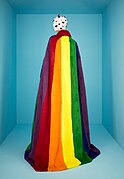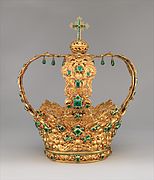The Fashion Portal
 | |

| |
Fashion is a term used interchangeably to describe the creation of clothing, footwear, accessories, cosmetics, and jewellery of different cultural aesthetics and their mix and match into outfits that depict distinctive ways of dressing (styles and trends) as signifiers of social status, self-expression, and group belonging. As a multifaceted term, fashion describes an industry, styles, aesthetics, and trends.
The term 'fashion' originates from the Latin word 'Facere,' which means 'to make,' and describes the manufacturing, mixing, and wearing of outfits adorned with specific cultural aesthetics, patterns, motifs, shapes, and cuts, allowing people to showcase their group belonging, values, meanings, beliefs, and ways of life. Given the rise in mass production of commodities and clothing at lower prices and global reach, reducing fashion's environmental impact and improving sustainability has become an urgent issue among politicians, brands, and consumers. (Full article...)
Selected article -

Loewe S.A. (/loʊˈɛveɪ/ loh-EV-ay, Spanish: [loˈeβe], German: [ˈløːvə]; stylized as LOEWE) is a Spanish luxury fashion house specialising in leather goods, clothing, perfumes and other fashion accessories. Founded in 1846 in Madrid, Loewe is part of LVMH since 1996, and is the oldest luxury fashion house of the holding.
The company was established in Madrid in 1846 by a group of Spanish leather craftsmen, and the brand was created in 1876 when Enrique Loewe joined the group. By the early 20th Century, many notable people took great interest in Loewe and Queen Victoria Eugenie became a regular customer. In 1905, Alfonso XIII granted them the Royal Warrant of Appointment and thus Loewe became Purveyor of the Royal Household of Spain. The company quickly grew in popularity and was promoted by figures such as Ernest Hemingway, Ava Gardner, Rita Hayworth, Marlene Dietrich and Sophia Loren amongst others. (Full article...)
Core topics -

A shirt is a cloth garment for the upper body (from the neck to the waist).
Originally an undergarment worn exclusively by men, it has become, in American English, a catch-all term for a broad variety of upper-body garments and undergarments. In British English, a shirt is more specifically a garment with a collar, sleeves with cuffs, and a full vertical opening with buttons or snaps (North Americans would call that a "dress shirt", a specific type of collared shirt). A shirt can also be worn with a necktie under the shirt collar. (Full article...)
Featured picture -

The "Darnley portrait", the official portrait of Elizabeth I of England, likely painted from life ca. 1575–76. This portrait is the source of a face pattern which would be used and reused for authorized portraits of Elizabeth into the 1590s, preserving the impression of ageless beauty. It features a crown and sceptre on a table beside the queen, and was the first appearance of these symbols of sovereignty separately used as props (rather than worn and carried) in Tudor portraiture, a theme that would be expanded in later portraits.
Did you know... -
- ... that William Hogarth was paid sixty guineas to paint Taste in High Life (engraving pictured), a 1742 oil-on-canvas that pokes fun at the fashion of the upper class?
- ...that less than two months after showing what would become the dress of the season for Spring 2006, Roland Mouret split from his backers and took a two-year hiatus from the fashion industry?
- ...that violent, porno-chic fashion photography in French and Italian Vogue influenced the sexualized glamor of cosmetics in the 1970s?
Selected biography -
Joanne Gair (born c. 1958), nicknamed Kiwi Jo (alternatively Kiwi Joe), is a New Zealand-born and -raised make-up artist and body painter whose body paintings have been featured in the Sports Illustrated Swimsuit Issue from 1999 to 2017. She is considered the world's leading trompe-l'œil body painter and make-up artist, and she became famous with a Vanity Fair Demi's Birthday Suit cover of Demi Moore in a body painting in 1992. Her Disappearing Model was featured on the highest-rated episode of Ripley's Believe It or Not. She is the daughter of George Gair.
In addition to achieving pop culture prominence and respect in the fashion and art worlds starting with her body painting of Demi Moore, she is a make-up artist in the rock and roll world who has helped several of her music clients win fashion and style awards. She is also considered a fashion and art trendsetter, and for a long time she was associated with Madonna. In 2001, she had her first retrospective and in 2005, she published her first book on body painting. At the peak of her pop culture fame after the Vanity Fair cover, she was seriously considered for an Absolut Vodka Absolute Gair ad campaign. She has done magazine editorial work, and in 2005, she became a photographer of her own body paintings in both books and magazines. (Full article...)
General images
Lua error: No content found on page "Women's beachwear fashion".
More Did you know (auto generated)

- ... that before his victory at the 1128 Battle of Axspoele, William Clito ordered his knights to cut their hair and remove opulent clothing as a sign of penance?
- ... that clothing physiology is the study of how clothing interacts with the human body and the environment?
- ... that the clothing tags for Alexander McQueen's first collection, Jack the Ripper Stalks His Victims, had McQueen's own hair encased inside?
- ... that Carlisle miser Margery Jackson, who chose to live like a pauper, possessed a fine court mantua?
- ... that the melting of the Platigliole Glacier in Italy has revealed artefacts of the White War, including clothing and hay more than 100 years old?
- ... that Berta Berkovich, who was skilled in sewing, managed to survive Auschwitz in a fashion salon established by the wife of the concentration camp commandant?
Selected quote -
Related portals
Topics
Featured content
Categories
Things you can do
- Fill out the red links on Portal:Fashion/Selected anniversaries
Wikimedia
The following Wikimedia Foundation sister projects provide more on this subject:
-
Commons
Free media repository -
Wikibooks
Free textbooks and manuals -
Wikidata
Free knowledge base -
Wikinews
Free-content news -
Wikiquote
Collection of quotations -
Wikisource
Free-content library -
Wikiversity
Free learning tools -
Wiktionary
Dictionary and thesaurus


































